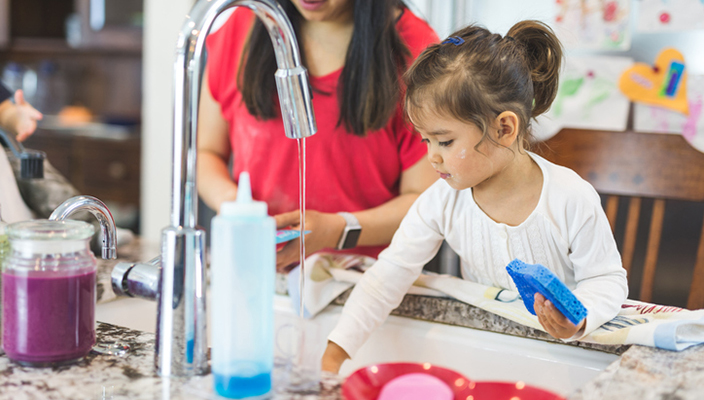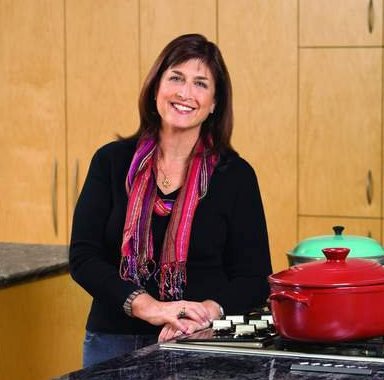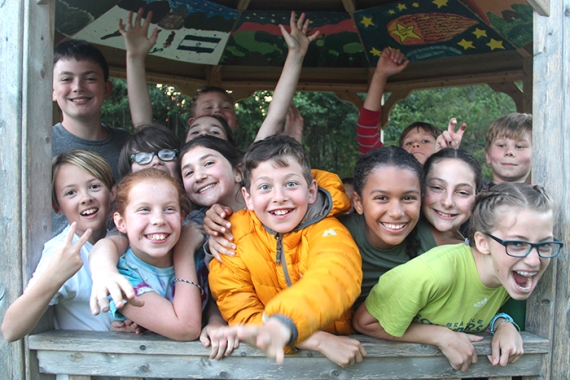
Remember Passover when you were growing up, with lots of preparation and tumult in the house? Perhaps you are old enough to remember a carp swimming in the bathtub, waiting unwittingly to be made into Grandma's special gefilte fish. Maybe you watched as the Hackmesser and wooden bowl were put on the counter filled with apples and walnuts to be pounded with the semi-luna blade to create the right consistency of . Mama made it look easy, but when you were old enough to pound the blade into that wobbly bowl you worked up a sweat and probably quit before the task was done.
If you grew up in a kosher home, were you enlisted to schlep the everyday pots and pans into the basement to make room for their Passover counterparts - stored for 51 weeks of the year near the boiler in the dark recesses of the house? The trip up the stairs with those heavy items was not easy. Remember the smell of chicken soup cooking on the stove in the large enameled pot that greeted you when you came home from school? Did you hold the little feather and wooden spoon and run around the already-transformed kitchen to find the one piece of bread – or other – your mother left for you to find during this traditional ritual?
If I have jogged your memories, what memories do your children and grandchildren have?
Let's find ways to give lasting Passover memories to the next generation – minus the bathtub fish – by involving them with the preparation for the holiday and its cooking.
Now, I can imagine you are shouting "Has she gone crazy? How am I to prepare the house and cook the food for 16+ people and have the children under foot? I barely have enough time doing it alone!"
If children participate in a few tasks, they will actually be less intrusive to the preparation than you would imagine. Grandparents, these fun activities are a perfect opportunity for you to bond with your grandchildren while helping alleviate some of the chaos in the kitchen.
Here are some activities that you can do with children that will be fun while reinforcing the meaning of Passover. I have given some guidelines for age-appropriate activities, but you are the best judge of the child's skills and attention span.
Before the holiday
- Even if you don't change your utensils for Passover, have children designate a drawer or shelf for Passover food.
- Have children help remove small, lightweight, non-Passover items and put them away in another part of the house. Do not have young children carry anything into a basement.
- Children of any age can create signs to be taped to cabinet doors or drawers that house your Passover groceries. It doesn't matter if they're just scribbles, the children will know that the contents behind the signs are special and unique to Passover.
- Supermarkets often have kid-sized shopping carts – let children push carts that hold all the matzah meal, cake meal, and farfel boxes – items that are lightweight and can't break. Your cart can hold the rest of the groceries.
- Use the supermarket as an opportunity to discuss what are and are not foods for Passover. Young children need simple concepts to build upon. It's like answering the question "where do babies come from?" – keep the explanations age appropriate.
- If you don't already do so, consider observing the custom of b'dikat chametz. You may have cleaned the house, but hide a non-Passover snack (like a small bag of crackers) and let children search the kitchen with a spoon and a feather to find it. They love this!
Food preparation
I am not suggesting that children constantly participate in the cooking. There are many tasks they can do that will not slow you up, but will keep them occupied.
- Peeling carrots for the chicken soup.
- Chopping charoset in a bowl (7 and older) or pressing the pulse button on the processor to help you make the mixture. This is a perfect time to reinforce counting: pulse 1, pulse 2, etc.
- Breaking off little sprigs of parsley for the seder – again, counting involved.
- Dropping spoonfuls of cookie batter onto the pan or making matzah meal bagels, but only if you have time. Remember, you have a week to cook with them after the seder!
Getting ready for the seder
In my home, all foods are preset at each place setting to facilitate the flow of the seder ceremony. This means, egg, salt water, parsley, charoset, and bitter herbs are pre-plated.
- Put water in a large measuring cup and a 7-year-old can pour it into the dish (a little water, if spilled, will dry up fast).
- A 3-year-old, given a small salt shaker can go to each water bowl and shake the salt 1, 2, 3. After all the place settings are done they should be able to count to three easily; just don't give them the box of salt!
- An older child can walk to each place setting with a bowl of peeled hard boiled eggs and a simple wire egg slicer. Sliced eggs in salt water are more delicious to eat (and similar to a Sephardi recipe for egg soup), and they also hide any bumps in the white from shelling.
- Very young children, if they can reach the table easily, can place the parsley on the plate to the right of the egg bowl – teaching them right from left.
- Spooning out the charoset can teach cooperation if one child holds the bowl while the other child spoons a little mixture on each plate. If the children are older than 6 or 7, they can take turns.
- Whether you use ground horseradish from the jar or sliced horseradish for your , the task of putting it out should be reserved for older children due to the need for careful handling. If you are using beet-colored ground horseradish, do it yourself – you will only have yourself to blame for red stains on your tablecloth or chairs!
After the seder
I distinguish one tablecloth (usually washable polyester) as my Memory Tablecloth. I give a fine permanent marker to my guests and have them each write their name on my tablecloth with the year. During the year, I embroider those names permanently onto the cloth. Imagine your guests' delight to find their name on the cloth the following Pesach! Imagine the progression of your child or grandchild's signature as they get older! Imagine passing that tablecloth on for generations.
Involving the youngest members of your family in the process of preparing for Passover will create indelible memories for them that will more than likely be re-created in their own homes when they are adults.
May you have a zissen (sweet) Pesach.



